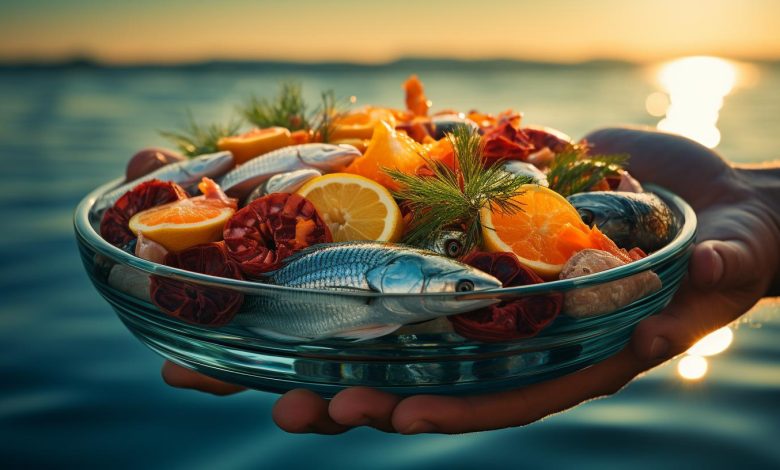Sustainable Seafood Choices: Making Responsible Decisions As A Consumer

You are what you eat, and when it comes to seafood, your choices as a consumer have a profound impact on the health of our oceans. It may sound like hyperbole, but sustainable seafood choices truly do make a world of difference.
The oceans cover over 70% of our planet’s surface and provide food for millions of people worldwide. However, unsustainable fishing practices such as overfishing, bycatch, and habitat destruction threaten the delicate balance of marine ecosystems.
As a responsible consumer, it’s crucial to educate yourself about sustainable seafood options and make informed decisions that support healthy oceans and thriving fish populations. Fortunately, identifying sustainable seafood choices is easier than ever before thanks to increased transparency in the fishing industry.
By choosing sustainably sourced seafood that has been harvested using environmentally friendly methods, you can help protect vulnerable species while also enjoying delicious meals at home or in restaurants. In this article, we’ll explore what sustainable seafood means and how to identify sustainable options when making purchasing decisions.
We’ll also offer tips for avoiding unsustainable choices while supporting practices that promote healthy ocean ecosystems.
Understanding Sustainable Seafood
You’re diving into the depths of the ocean, exploring the intricate ecosystems that support a diverse array of marine life. As you explore further, you come to realize how important it is for humans to adopt sustainable fishing techniques and ocean conservation efforts.
By doing so, we can help maintain the health and balance of our oceans and ensure that future generations are able to enjoy its bounty. Sustainable fishing techniques involve practices that do not harm or damage the marine ecosystem. This includes avoiding overfishing by setting catch limits, using gear that minimizes unintended bycatch, and reducing waste by utilizing every part of the fish.
Additionally, ocean conservation efforts such as protecting marine habitats and reducing pollution also play an important role in maintaining sustainable seafood choices. Understanding these concepts will allow you to make informed decisions when identifying sustainable seafood choices without harming our oceans.
Identifying Sustainable Seafood Choices
When it comes to identifying sustainable seafood choices, there are a few key points to keep in mind.
Firstly, look for certifications from trusted organizations that verify the sustainability of the seafood you’re interested in.
Secondly, research fishing methods used by different suppliers and make sure they align with sustainable practices.
Lastly, consider choosing local and seasonal options as these tend to have less impact on the environment and support local communities.
By following these guidelines, you can make responsible decisions as a consumer and contribute to the protection of our oceans’ ecosystems.
Looking for Certifications
If you want to ensure that the fish on your plate is ethically sourced, there’s one important thing you should be on the lookout for: certifications.
Many organizations dedicate themselves to sustainable fishing practices and provide certifications that denote their products as such. For example, some of the most well-known certification programs are the Marine Stewardship Council (MSC) and Aquaculture Stewardship Council (ASC). These certifications guarantee that seafood has been responsibly caught or farmed using environmentally-sound methods.
Additionally, some eco-friendly packaging may also indicate a product’s sustainability credentials, so make sure to check labels carefully.
By looking for these certifications and traceability systems along with eco-friendly packaging, you can feel confident in your choice of seafood. However, don’t stop at just checking for certifications!
There are many other factors that contribute to sustainable seafood choices such as researching fishing methods. By doing so, you can get a better understanding of how different types of fish are caught and whether those methods align with your personal values and ethics.
Remember – every small step towards responsible consumption counts!
Researching Fishing Methods
Let’s dive into researching different fishing methods to gain a better understanding of how our fish ends up on our plates.
When it comes to sustainable seafood choices, it’s important to consider the fishing methods used. One thing to look for is bycatch reduction techniques, which help minimize the number of unintended species caught while fishing for target species. Bycatch can be a serious issue that leads to unnecessary waste and harm to other ocean life.
Another factor to consider is aquaculture practices, which involve farming fish in controlled environments rather than catching them in the wild. This can be a more sustainable option because it reduces pressure on wild fish populations and allows for better regulation and monitoring of the environmental impact. However, it’s important to research specific aquaculture practices as some may have negative impacts on water quality or require large amounts of wild fish as feed.
By taking these factors into account when choosing your seafood options, you can make informed decisions that support responsible fishing practices and protect our oceans.
When considering sustainable seafood choices, researching different fishing methods is just one step towards making responsible decisions as a consumer. The next section will explore another important factor: choosing local and seasonal options.
Choosing Local and Seasonal Options
It’s crucial to opt for nearby and in-season options to truly savor the freshest, most flavorsome fish possible. Seasonal availability and local sourcing are important factors to consider when making sustainable seafood choices. By choosing fish that is currently in season, you can guarantee it has been harvested at its peak freshness and flavor.
Additionally, opting for locally sourced fish not only supports your community’s economy but also ensures that the seafood has a smaller carbon footprint due to reduced transportation. When selecting your seafood options, research what types of fish are currently in season in your area and where they were caught.
Local fishermen’s markets or small-scale fisheries are great places to source fresh and sustainable seafood options. Not only will you be able to enjoy delicious, high-quality seafood, but you’ll also be supporting responsible fishing practices that prioritize environmental conservation.
By taking these steps towards sustainable consumption habits, we can help preserve our marine ecosystems for future generations. By choosing local and seasonal options for your seafood meals, you’re already on the right track towards making responsible decisions as a consumer. But there are still other factors to consider when it comes to avoiding unsustainable seafood choices.
Let’s take a closer look at how we can make informed decisions about the types of fish we consume without compromising on taste or nutrition.
Avoiding Unsustainable Seafood Choices
You can ensure the health of our oceans by being mindful of what you order at restaurants and purchase at the grocery store. Avoiding unsustainable seafood choices is a crucial step towards preserving marine life. According to Seafood Watch, overfishing has caused a decline in fish populations around the world, leading to irreversible damage to entire ecosystems. By choosing sustainable options, you’re helping to reduce this impact.
Here are three ways you can avoid unsustainable seafood choices:
– Research before purchasing or ordering: Use resources like Seafood Watch to determine which species are overfished or caught in environmentally harmful ways.
– Choose alternative options: Instead of opting for popular but unsustainable species like bluefin tuna or farmed salmon, try more sustainable alternatives such as sardines or mussels.
– Ask questions: When dining out, don’t be afraid to ask your server where the seafood comes from and how it was caught. This will not only help you make an informed decision but also encourage restaurants to prioritize sustainability in their sourcing practices.
Making responsible decisions about seafood doesn’t stop at avoiding unsustainable options.
Let’s explore how you can take further steps towards making sustainable seafood choices at home.
Making Sustainable Seafood Choices at Home
Transform your home cooking into an eco-friendly feast by discovering simple yet effective ways to support marine conservation. Start with grocery shopping and choose seafood that is sustainably sourced, such as wild-caught Alaskan salmon or farmed clams from a certified organic farm. These certifications ensure that the seafood you purchase has been caught or farmed in a way that minimizes harm to the environment and maintains the health of fish populations.
When it comes to recipe ideas, consider opting for plant-based meals or incorporating sustainable seafood options like sardines, mackerel, or anchovies which are lower on the food chain and thus have less impact on the environment. Additionally, try making use of all parts of the fish to reduce waste – use bones and scraps to make flavorful stocks and broths.
By making these small changes in your home cooking practices, you can play a role in supporting sustainable seafood practices and preserving our ocean ecosystems for future generations.
Supporting sustainable seafood practices doesn’t just mean avoiding unsustainable choices; it also means actively seeking out responsibly sourced options.
In the next section, we’ll explore how you can take things a step further by advocating for change within your community.
Supporting Sustainable Seafood Practices
Now that you know how to make sustainable seafood choices at home, it’s time to take the next step and support sustainable seafood practices as a consumer. Consumer education is an important part of promoting sustainable fishing practices and protecting our oceans for future generations. By making responsible decisions when purchasing seafood, you can help create demand for sustainably sourced products and encourage the fishing industry to adopt more environmentally friendly practices.
The responsibility doesn’t solely fall on consumers, however. The fishing industry also plays a crucial role in promoting sustainability. Many fisheries have already made significant strides towards reducing their impact on the environment, but there is still work to be done. By supporting companies that prioritize sustainability and holding others accountable for their actions, we can push the industry towards more responsible practices.
With both consumers and industry working together towards a common goal, we can ensure that our oceans remain healthy and productive for years to come.
Ways You Can Support Sustainable Seafood Practices:
– Look for certifications such as MSC (Marine Stewardship Council) or ASC (Aquaculture Stewardship Council) when purchasing seafood.
– Choose locally sourced fish whenever possible to reduce carbon emissions from transportation.
Ways The Fishing Industry Can Promote Sustainability:
– Implementing better fishing techniques such as using nets with larger mesh sizes or avoiding areas with sensitive habitat.
– Supporting research efforts aimed at improving sustainability in the fishing industry through innovative solutions.
Conclusion
Congratulations on taking the first step towards making responsible decisions as a consumer when it comes to seafood! By understanding what sustainable seafood means and identifying sustainable choices, you can make a positive impact on the health of our oceans and the livelihoods of fishermen.
Remember, avoiding unsustainable choices is just as important as choosing sustainable ones. Take the time to research and ask questions about where your seafood comes from and how it was caught or farmed. And don’t forget that making sustainable seafood choices at home can be easy and delicious with simple swaps like opting for sardines instead of tuna.
As the proverb goes, “We don’t inherit the earth from our ancestors; we borrow it from our children.” Let’s make sure we leave behind a healthy ocean for future generations by supporting sustainable seafood practices.
Together, we can make a difference.


